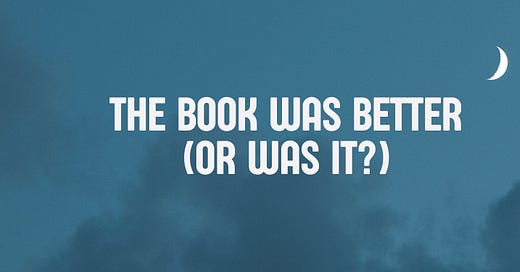The Book Was Better (Or Was It?)
Film and TV adaptations are powerful opportunities for underrepresented authors.
A key component of Moonbeam’s mission is to adapt and expand the story-IP of our underrepresented clients into film, TV and other digital media.
In today’s installment, we explore why media adaptations are an important part of our strategy, and why more work needs to be done to adapt diverse children’s stories.
Adaptations can miss the mark, but potential benefits prevail.
You’ve likely experienced it personally—the excitement of seeing beloved characters leap off the page, or the disappointment when they don't match the worlds we built in our minds.
Watching a screen adaptation of your favorite childhood book can be tumultuous when it fails to capture the magic of the original. Still, when adaptations exceed our expectations, they can breathe new life into cherished tales and introduce them to new audiences.
Think of Roald Dahl classics like Matilda and Charlie and the Chocolate Factory, which have each been iterated and spun-off in numerous formats for decades past, even as recently as last December for a new generation in the case of Wonka.
From a film or TV producer’s perspective, adapting existing IP reduces some of the risks with creating original content.
A built-in fan base
Established storylines and structure
Recognizable characters
Additionally, adaptation allows for creative reinterpretation and exploration within established universes.
You can’t ignore the commercial and critical appeal around film and TV adaptations of books.
The fact is, book IP is king.
Globally, films adapted from books generate 53% more revenue than original screenplays, or an extra $91M more per film, according to a study by Frontier Economics.
Moreover, film adaptations perform better in terms of critical acclaim and awards; on a 5-star rating scale, adapted source material adds half a star.
TV shows demonstrate similar positive effects for book adaptations. Compared to original screenplays, TV adaptations garner on average 58% higher viewership per episode and 19% more reach (total distinct viewers during a show’s run).
Importantly, the original source material also receives a boost in sales and influence following the success of a film or TV adaptation. This provides further benefit to the original story-makers in growing their audience and impact.
Currently, more than half of the industry’s top-20 grossing films of all time were based on books, fairy tales, comics or plays.
Virtually all of these top-performing adaptations were originally sourced from kids content and IP, and/or made for kids as the target audience—the Marvel Cinematic Universe sourced from comics, the Frozen franchise, The Lion King, and Harry Potter, to name the main players.
So it’s clear just how strongly literary content for children and young adults—incidentally, Moonbeam’s target demographic—can translate to the screen.
Unfortunately, underrepresented authors in children’s storytelling have rarely had their stories adapted to film and TV.
Historically, diverse books and their diverse storytellers have been under-hyped in publishing’s sales and marketing engine—a systemic issue that we referenced last week.
The narrative that “diverse books don’t sell” results in very few opportunities for underrepresented stories to be expanded into film and TV adaptations.
These are missed opportunities to further develop content with universal appeal and fresh perspectives from marginalized communities.
Such communities stand to benefit the most from the increase in influence and visibility, whether socio-economically, politically or psychologically.
We performed our own survey of the adaptation landscape for racial diversity. Confirming what we already knew, the data revealed that out of 253 children’s books adapted to the screen since 1939, only nine (<4%) were based on books that were originally written by a person of color.
Surely, we can do better than that.
How will Moonbeam address the gap?
Ultimately, Moonbeam exists to amplify underrepresented voices and their stories across both publishing and media (film, TV, digital media).
These major industries feed into each other for symbiotic opportunities that will increase our artists’ reach.
To start, we pledge to work with our literary talent to:
Advocate relentlessly for media expansion of their IP
Determine which media formats best translate their unique stories cinematically, while also setting up for commercial success
Understand innately what draws readers and audiences to their beloved characters, and adapt accordingly
Choose the right team and partners to authentically support the adaptation
Protect their artist rights
Exciting times ahead—and we can’t wait.
Sincerely,
Jesse & Rebecca








